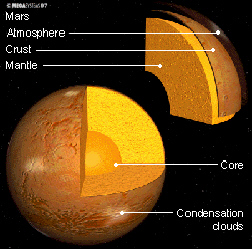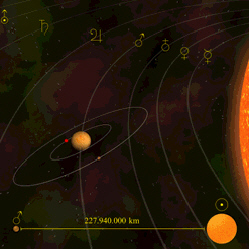|
|
|
MARS
Mars / Introduction
Our next neighbor is actually the planet in the Solar System most similar to
our own. Mars is named after the Roman god of war (Ares in Greek).
 The
men from Mars that science-fiction authors like to tell us about are often
an equally aggressive lot as this Roman god and his companions. There are
for example innumerable stories of Martians invading and destroying the
earth. The
men from Mars that science-fiction authors like to tell us about are often
an equally aggressive lot as this Roman god and his companions. There are
for example innumerable stories of Martians invading and destroying the
earth.
Could there actually be life on Mars? The American P. Lowellwas convinced of
this and inter-preted the channels on the planet’s surface, which were first
discovered by the astronomer Schiaparelliin 1877, as parts of an artificial
irrigation system. In 1976, the Viking spacecraft confirmed though that Mars
does not allow for highly developed life. It even appeared that the channels
were only an optical illusion. The possibility that there ever were or still
are very primitive forms of life on Mars cannot be fully excluded but it is
rather unlikely.
Mars is about half the size of the earth. A day on Mars is only 40 minutes
longer than a day on the earth. There are distinct seasons that last
approximately 6 earth months each. The maximum distance from the earth is
approximately 400 million kilometers. The closest the two planets can ever
be is 55.65 million kilometers apart from each other.
It takes Mars approximately 2 earth years to complete a full orbit around
the sun. The climate is generally colder than that on the earth with an
average temperature of minus 25 °C and a temperature range from plus 20 °C
to minus 120 °C. As a consequence of the weak gravitational forces of Mars,
it has only a very thin atmosphere which is unable to conserve the heat from
the sun and therefore cools down quickly. The atmosphere is made up of 95%
carbon dioxide.
Why does Mars appear to us as a red ball? The reason for this is the surface
dust of the planet, which contains hydrated iron oxide or simply - rust.
Orbit of Mars
Our neighbor Mars is the fourth planet from the sun. Its orbit is not
parallel to the orbit of the earth and this results in considerable
fluctuation regarding the distance between the two planets.
 They
are closest to each otherwhen they are in opposition, i.e. when the sun, the
earth and Mars are in one line. They
are closest to each otherwhen they are in opposition, i.e. when the sun, the
earth and Mars are in one line.
Mars has a rather eccentric orbitand therefore, the distances during
oppositions vary considerably. At the last aphelion (Mars at greatest
distance from the sun) on February 12th,1995, the distance between Mars and
the earth was approximately 101 million kilometers.
At the next perihelion (Mars at shortest distance to the sun) on August
28th, 2003, there will be "only" 55.8 million kilometers between them. When
Mars and the earth are in conjunction, they are at maximum distance to each
other, i.e. 400 million kilometers apart. It takes Mars just about two earth
years or 687 days to complete a full orbit around the sun.
When observing Mars for a longer period, one observes that the planet seems
to stop and return in the opposite direction of its normal orbit (retrograde
movement). This phenomenon is caused by the different orbit velocities of
the earth and Mars. During opposition, the earth ”overtakes“ Mars, which has
a far greater distance to travel.
Mars Surface
The most striking feature of the surface of Mars is its red color, which can
even be observed by the naked eye. The color derives from the iron compounds
found in the rocks and dust of the planet. In other words, Mars is rusty.
 There
are various landscapes to befound on Mars. Besides areas with distinct
craters and mountains, there are extensive deserts, icy polar regions, deep
gorges as well as high volcanoes. There
are various landscapes to befound on Mars. Besides areas with distinct
craters and mountains, there are extensive deserts, icy polar regions, deep
gorges as well as high volcanoes.
The craters were caused by meteorite impacts,which are, in contrast to the
ones on Venus, partly eroded. On Mars, strong winds up to gale force were
observed. These winds raise dust from the surface and make the thin
atmosphere of the planet appear in a redglow. Such dust and sand storms
sometimes continue for several months and, as was the case in 1971, may
completely obscure the surface of Mars. The forces of erosion on Mars are
very limited though compared with the ones on the earth. Mars is not exposed
to the effects of plate tectonics as there are no continental plates.
The crust of Mars consists of one single plate and therefore, very large
volcanoes could develop. A real giant is the volcano Olympus Mons. It is
actually the highest mountain in the Solar System Its diameter is
approximately 600 kilometers and its top is 27,000 meters high, which is
more than three times the height of Mount Everest.Of equally impressive
dimensions are the valley systems on Mars. Near the equator extends the huge
plane of the Valles Marineres with gorges four times deeper and ten times
longer than the Grand Canyon. Astronomers have also discovered that the
weather on Mars varies according to the accompanying cloud formations,
similar to the weather development on earth.Mars also has seasons.
During the Martian summer, temperatures reach a peak of over plus 10 °C. The
ice on the south pole disappears almost completely. It dissipates into gas
form and no water in liquid form has been found on Mars.
The shapes of existing dry river beds indicate that there was water in
liquid form on Mars in the dim and distant past. It is possible that there
are still permafrost layers below the surface of Mars, similar to that of
our tundras.
Mars Rotation
A Martian day is 24 hours and 37 minutes long. This is the time it takes
Mars to complete a full rotation on its own axis. The axis of rotation is
inclined towards the orbit plane by 24 degrees, which is very similar to the
inclination of the earth’s axis (difference of 1.7 degrees).
 It
is this inclination of the axis that results in the different seasons that
can be observed on Mars. Certain areas are at certain timesmore exposed to
or shaded fromthe direct light of the sun . It
is this inclination of the axis that results in the different seasons that
can be observed on Mars. Certain areas are at certain timesmore exposed to
or shaded fromthe direct light of the sun .
As Mars has a longer orbit cycle than our planet, the Martian seasons are
approximately double those of the earth. One Martian year equals 687 earth
days.
©by megasystems
|
|
|